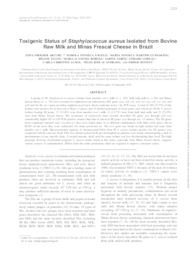Toxigenic status of Staphylococcus aureus isolated from bovine raw milk and minas frescal cheese in Brazil.
Toxigenic status of Staphylococcus aureus isolated from bovine raw milk and minas frescal cheese in Brazil.
Autoria: ARCURI, E. F.; BORGES, M. de F.; LANGE, C. C.
Resumo: A group of 291 Staphylococcus aureus isolates from mastitic cow's milk (n = 125), bulk tank milk (n = 96), and Minas frescal cheese (n = 70) were screened for staphylococcal enterotoxin (SE) genes (sea, seb, sec, sed, see, seg, seh, sei, selj, and sell) and for the tst-1 gene encoding staphylococcal toxic shock syndrome toxin 1 by PCR assay. A total of 109 (37.5%) of the isolates were positive for at least one of these 11 genes, and 23 distinct genotypes of toxin genes were observed. Of the S. aureus isolates bearing SE genes, 17 (13.6%) were from mastitic cow's milk, 41 (41.7%) were from bulk tank milk, and 51 (72.9%) were from Minas frescal cheese. The occurrence of exclusively more recently described SE genes (seg through sell) was considerably higher (87 of 109 PCR-positive strains) than that of classical SE genes (sea through see, 15 strains). The SE genes most commonly detected were seg and sei; they were found alone or in different combinations with other toxin genes, but in 60.8% of the cases they were codetected. No strain possessed see. The tst-1 gene was found in eight isolates but none from mastitic cow's milk. Macrorestriction analysis of chromosomal DNA from 89 S. aureus isolates positive for SE gene(s) was conducted with the enzyme SmaI. Fifty-five distinct pulsed-field gel electrophoresis patterns were found, demonstrating a lack of predominance of any specific clone. A second enzyme, ApaI, used for some isolates was less discriminating than SmaI. The high genotype diversity of potential toxigenic S. aureus strains found in this study, especially from Minas frescal cheese, suggests various sources of contamination. Efforts from the entire production chain are required to improve consumer safety.
Ano de publicação: 2010
Tipo de publicação: Artigo de periódico
Unidade: Embrapa Gado de Leite
Palavras-chave: Minas frescal cheese, Staphylococcus Aureus
Observações
1 - Por padrão são exibidas publicações dos últimos 20 anos. Para encontrar publicações mais antigas, configure o filtro ano de publicação, colocando o ano a partir do qual você deseja encontrar publicações. O filtro está na coluna da esquerda na busca acima.
2 - Para ler algumas publicações da Embrapa (apenas as que estão em formato ePub), é necessário ter, no celular ou computador, um desses softwares gratuitos. Sistemas Android: Google Play Livros; IOS: iBooks; Windows e Linux: software Calibre.
Acesse outras publicações
Acesse a Base de Dados da Pesquisa Agropecuária (BDPA) para consultar o acervo completo das bibliotecas da Embrapa.

